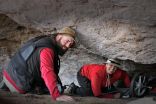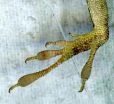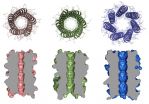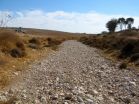INFORMATION:
Highest altitude archaeological sites in the world explored in the Peruvian Andes
University of Calgary archaeologist investigates human capacity for survival in extreme environments
2014-10-23
(Press-News.org) Research conducted at the highest-altitude Pleistocene archaeological sites yet identified in the world sheds new light on the capacity of humans to survive in extreme environments.
The findings, to be published in the Oct. 24 edition of the academic journal Science – co-authored by a team of researchers including University of Calgary archaeologist Sonia Zarrillo – were taken from sites in the Pucuncho Basin, located in the Southern Peruvian Andes.
The primary site, Cuncaicha is a rock shelter at 4,480 metres above sea level, with a stone-tool workshop below it. There is also a Pucuncho workshop site where stone tools were made at 4,355 metres above sea level. Climatic conditions in both sites are harsh, with factors including low-oxygen, extreme cold and high levels of solar radiation making life in the region a challenge for any humans. And yet, the findings indicate that people were living in these high altitude zones for extended periods of time. Cuncaicha was occupied about 12.4 to 11.5 thousand years ago while the Pucuncho workshop site dates to around 12.8 to 11.5 thousand years ago.
"We don't know if people were living there year round, but we strongly suspect they were not just going there to hunt for a few days, then leaving," says Zarrillo. "There were possibly even families living at these sites, because we've found evidence of a whole range of activities."
Archaeological evidence found at Cuncaicha includes signs of habitation such as human skull fragments, animal remains and stone tools. "Hunters passing through an area will take the meat back to campsites and leave the carcass in the field," says Zarrillo. "In Cuncaicha we found remains representing whole animals, indicating they were living close to where the animals were killed. And the types of stone tools we've found are not only hunting tools but also scraping tools used for processing hides to make things like clothing, bags or blankets."
A popular scientific theory about high altitude colonization suggests that people cannot live in high altitudes until genetic adaptation occurs, like the sort we find in Andean people today. Andeans have genetically adapted to their high altitude environment, Zarrillo notes. Key differences in the Andean people include a higher metabolic rate, larger lung capacity and higher hemoglobin concentrations then the average person, all of which allow them to overcome a lack of oxygen.
"Was this adaptation present 12,400 years ago? We don't know for certain," says Zarrillo. "What we're demonstrating is that these people either already developed that adaptation, or, it was possible for them to live in these altitudes for extended periods of time regardless. Finding this out is one of the goals of our future research." Zarrillo believes that other sites in the region have the potential for further ground breaking revelations, in part because they're incredibly well preserved.
"Research really hasn't been done here up until now, because it's so remote," she says. "Our team hiked up to three or four hours to get to these sites. That was a climb, carrying all of our gear, camp equipment and food. And it freezes every night. Sometimes it snows. These are incredibly hard sites to access."
ELSE PRESS RELEASES FROM THIS DATE:
Florida lizards evolve rapidly, within 15 years and 20 generations
2014-10-23
Scientists working on islands in Florida have documented the rapid evolution of a native lizard species — in as little as 15 years — as a result of pressure from an invading lizard species, introduced from Cuba.
After contact with the invasive species, the native lizards began perching higher in trees, and, generation after generation, their feet evolved to become better at gripping the thinner, smoother branches found higher up.
The change occurred at an astonishing pace: Within a few months, native lizards had begun shifting to higher perches, and over ...
Berkeley Lab study reveals molecular structure of water at gold electrodes
2014-10-23
When a solid material is immersed in a liquid, the liquid immediately next to its surface differs from that of the bulk liquid at the molecular level. This interfacial layer is critical to our understanding of a diverse set of phenomena from biology to materials science. When the solid surface is charged, just like an electrode in a working battery, it can drive further changes in the interfacial liquid. However, elucidating the molecular structure at the solid-liquid interface under these conditions has proven difficult.
Now, for the first time, researchers at the US ...
How ferns adapted to one of Earth's newest and most extreme environments
2014-10-23
Ferns are believed to be 'old' plant species – some of them lived alongside the dinosaurs, over 200 million years ago. However, a group of Andean ferns evolved much more recently: their completely new form and structure (morphology) arose and diversified within the last 2 million years. This novel morphology seems to have been advantageous when colonising the extreme environment of the high Andes.
Dr Patricia Sanchez-Baracaldo (Bristol) and Dr Gavin Thomas (Sheffield) used molecular and morphological data to study a group of ferns which grow in a unique ecosystem ...
Bristol team creates designer 'barrel' proteins
2014-10-23
Proteins are long linear molecules that fold up to form well-defined 3D shapes. These 3D molecular architectures are essential for biological functions such as the elasticity of skin, the digestion of food, and the transport of oxygen in blood.
Despite the wide variety of tasks that natural proteins perform, they appear to use only a limited number of structural types, perhaps just a few thousand or so. These are used over and over again, being altered and embellished through evolution to generate many different functions. This raises the question: are more protein ...
Dartmouth study measures breast cancer tumor response to neoadjuvant chemotherapy
2014-10-23
A Dartmouth study suggests that it may be possible to use Diffuse Optical Spectroscopic Tomographic imaging (DOST) to predict which patients will best respond to chemotherapy used to shrink breast cancer tumors before surgery. These findings could eliminate delays in effective early treatment for tumors unlikely to respond to neoadjuvant chemotherapy (NAC). The study, "Predicting breast tumor response to neoadjuvant chemotherapy with Diffuse Optical Spectroscopic Tomography prior to treatment," was published online in Clinical Cancer Research on October 7, 2014.
Breast ...
Synthetic biology on ordinary paper, results off the page
2014-10-23
BOSTON - New achievements in synthetic biology announced today by researchers at the Wyss Institute for Biologically Inspired Engineering, which will allow complex cellular recognition reactions to proceed outside of living cells, will dare scientists to dream big: there could one day be inexpensive, shippable and accurate test kits that use saliva or a drop of blood to identify specific disease or infection — a feat that could be accomplished anywhere in the world, within minutes and without laboratory support, just by using a pocket–sized paper diagnostic ...
Desert streams: Deceptively simple
2014-10-23
(Santa Barbara, Calif.) — Volatile rainstorms drive complex landscape changes in deserts, particularly in dryland channels, which are shaped by flash flooding. Paradoxically, such desert streams have surprisingly simple topography with smooth, straight and symmetrical form that until now has defied explanation.
That paradox has been resolved in newly published research conducted by Michael Singer and Katerina Michaelides, associate researchers at UC Santa Barbara's Earth Research Institute. The pair show that simple topography in dryland channels is maintained ...
UT Southwestern scientists discover new clues to how weight loss is regulated
2014-10-23
DALLAS – Oct. 23, 2014 – A hormone seen as a popular target to develop weight-loss drugs works by directly targeting the brain and triggering previously unknown activity in the nervous system, UT Southwestern Medical Center obesity researchers have found.
The fibroblast growth factor 21 (FGF21) hormone has been a key target for developing weight-loss drugs because the protein increases energy expenditure, causing the body to burn calories. But how the hormone worked wasn't known until now.
UT Southwestern researchers tracking the hormone discovered that ...
European multicenter harmonization study shows anaplastic lymphoma kinase immunohistochemistry testing comparable to, if not better than, fluorescence in situ hybridization testing
2014-10-23
DENVER – Sixteen institutions across Europe collaborated together to show for the first time that a semi-quantitative anaplastic lymphoma kinase (ALK) protein expression test, immunohistochemistry (IHC), is reliable amongst several laboratories and reviewers when test methodology and result interpretation are strictly standardized and the scoring pathologists are appropriately trained on the test.
ALK tyrosine kinase inhibitors (TKIs) shrink tumors and increase progression-free survival in late-stage non-small cell lung cancer (NSCLC) patients positive for ALK as ...
Novel software application can stratify early-stage non-small cell lung cancer patients
2014-10-23
DENVER –CANARY, Computer-Aided Nodule Assessment and Risk Yield, is a novel software tool developed at Mayo Clinic that can automatically quantitate adenocarcinoma pulmonary nodule characteristics from non-invasive high resolution computed tomography (HRCT) images and stratify non-small cell lung cancer (NSCLC) patients into risk groups that have significantly different disease-free survival outcomes.
The majority of NSCLC patients are diagnosed with advanced-stage disease which is concomitant with an exceptionally poor prognosis, 5-year survival rate of 4%. In ...
LAST 30 PRESS RELEASES:
Salk Professor Satchin Panda named 2023 AAAS fellow
New urine test has higher diagnostic accuracy for prostate cancer
Floating solar’s potential to support sustainable development by addressing climate, water, and energy goals holistically
Drawing a line back to the origin of life
Data-driven music: Converting climate measurements into music
Palaeontology: Discovery of new ancient giant snake in India
Racial discrimination and metabolic syndrome in young Black adults
Adherence to American Cancer Society nutrition and physical activity guidelines among cancer survivors
New urine-based test detects high-grade prostate cancer, helping men avoid unnecessary biopsies
Researchers reduce bias in pathology AI algorithms using foundation models
Properties of new materials for microchips can now be measured well
Maltreated children are three times more likely to develop substance use disorders in adulthood
Two U professors selected as AAAS fellows
Dana-Farber Chief Scientific Officer, Kevin Haigis, PhD, elected as Fellow of the American Association for the Advancement of Science
Siblings with unique genetic change help scientists progress drug search for type 1 diabetes
Four MD Anderson researchers elected AAAS Fellows
Computational biology pioneer Katie Pollard elected as AAAS fellow
New “window-of-opportunity” clinical trials explore cutting-edge treatments for cancers of the liver, head and neck
Can bismuth prevent oil leaks – (and save Norwegians billions)?
Atmospheric isotopes reveal 4.5 billion years of volcanism on Jupiter’s moon Io
An ink for 3D-printing flexible devices without mechanical joints
Association for Chemoreception Sciences (AChemS) 46th Annual Meeting
How the Birmingham Drug Discovery Hub created an investment-ready ‘drug library’
Scientists uncover 95 regions of the genome linked to PTSD
AI tool predicts responses to cancer therapy using information from each cell of the tumor
CEOs’ human concern translates into higher stock price
Smoking-related deaths could be reduced if people attending lung cancer screening are offered stop-smoking support
Quick decisions in soccer enhanced by brain’s ability to suppress actions
Recycling CFRP waste is a challenge, but we've found a way to make it work
Advanced nuclear magnetic resonance technique developed to reveal precise structural and dynamical details in zeolites
[Press-News.org] Highest altitude archaeological sites in the world explored in the Peruvian AndesUniversity of Calgary archaeologist investigates human capacity for survival in extreme environments





